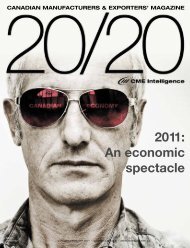The New - 20/20 Magazine
The New - 20/20 Magazine
The New - 20/20 Magazine
Create successful ePaper yourself
Turn your PDF publications into a flip-book with our unique Google optimized e-Paper software.
Facing the Carbon Challenge<br />
By Anthony D’Agostino<br />
Director, Emissions Markets,<br />
Royal Bank of Canada<br />
Climate change and greenhouse gas<br />
(GHG) emissions aren’t just environmental<br />
issues – they’re also business issues.<br />
That’s how they need to be considered if<br />
the manufacturing sector is to effectively<br />
reduce its emissions.<br />
<strong>The</strong> sector’s contribution to GHG<br />
emissions in Canada is about 15%,<br />
according to a <strong>20</strong>09 CME paper.<br />
Thanks to improvements in energy<br />
efficiency, replacement of industrial<br />
processes, fuel switching and other<br />
measures, the CME notes that<br />
emissions in manufacturing have<br />
been falling since the 1990s (Climate<br />
Change Policy in <strong>20</strong>09, CME <strong>20</strong>09).<br />
Industry leaders realize that getting a<br />
handle on emissions is simply smart<br />
business. Carbon is – or will be – a risk<br />
for any manufacturer. Customers<br />
(whether end consumers or other<br />
businesses), shareholders, financial<br />
markets and ultimately regulators will<br />
all demand action – concrete steps to<br />
quantify, disclose and control your<br />
carbon footprint. <strong>The</strong> key question:<br />
are you prepared?<br />
Mix of reduction approaches<br />
Start with the current regulatory<br />
landscape. Much of the world is<br />
watching to see what the U.S. will do<br />
when it comes to regulating carbon<br />
emissions. <strong>The</strong>se proceedings will<br />
heavily influence legislation in other<br />
jurisdictions, including Canada.<br />
advErTorIal<br />
<strong>The</strong> latest talk in the U.S. Senate<br />
involves a utilities-only carbon bill.<br />
That narrows the group of emitters<br />
affected, including some carbonintensive<br />
industries. That’s how the<br />
political winds are blowing now – but<br />
the utilities plan, if enacted, may be<br />
just a start.<br />
In Canada, we already see a mix of<br />
approaches.<br />
Currently, there is no national regulation<br />
on GHG emissions reduction; however,<br />
the federal government has taken action<br />
to promote energy efficiency and<br />
technological developments in the field,<br />
outlined a domestic GHG offset system<br />
and established GHG reporting systems.<br />
<strong>The</strong> federal commitment remains to<br />
reduce Canada’s GHG emissions by<br />
17% from <strong>20</strong>05 to <strong>20</strong><strong>20</strong>, which is<br />
aligned with the U.S. target (and<br />
subject to adjustment to remain<br />
consistent with the U.S. target).<br />
on the provincial front, B.C. has a<br />
carbon tax. alberta’s Specified Gas<br />
Emitters regulation requires facilities<br />
emitting over 100,000 tonnes/year to<br />
reduce their carbon emissions intensity.<br />
and the Western Climate Initiative –<br />
involving six U.S. states plus B.C.,<br />
Manitoba, ontario and Quebec –<br />
proposes launching a regional cap-<br />
and-trade system on Jan. 1, <strong>20</strong>12.<br />
Markets manage cap-and-trade<br />
Carbon is usually priced in metric<br />
tonnes, with prices varying depending<br />
on the program. For example,<br />
allowances from the Chicago Climate<br />
Exchange program trade at US$0.10/<br />
metric tonne, whereas EU emission<br />
allowances (EUas) trade at €14.50/<br />
metric tonne. Many programs and<br />
jurisdictions fall between these price<br />
levels. <strong>The</strong> wide ranges are due to<br />
different perceptions of value and<br />
whether there is a compliance need.<br />
When companies see a price on<br />
carbon, they can make informed<br />
decisions about how to abate it.<br />
That’s why market mechanisms like<br />
cap-and-trade can be so effective.<br />
With cap-and-trade, for instance,<br />
governments set caps on carbon<br />
emissions, and it’s up to the<br />
emitters to find ways to stay within<br />
their cap. often, the government<br />
allocates or auctions an amount of<br />
carbon credits that equals the cap.<br />
If you fall below the cap, you can<br />
sell excess credits; above, you can<br />
buy credits from an emitter that<br />
doesn’t need all its credits.<br />
<strong>The</strong> worldwide value of carbon<br />
trading was US$136 billion last<br />
year, more than double what it<br />
was two years ago. as an example<br />
of this growth, rBC has traded<br />
over 225 million tonnes of carbon<br />
instruments globally, helping<br />
companies hedge their exposure<br />
to the carbon market through<br />
instruments like forwards, futures<br />
and options.<br />
Europe currently has the world’s<br />
biggest carbon market. <strong>The</strong>ir<br />
cap-and-trade plan covers sectors<br />
that include oil and gas; pulp and<br />
paper; public power and heat<br />
(industrial/district heating);<br />
cement, lime and gas; metals;<br />
and “other” – a wide swath of<br />
manufacturing companies that<br />
have to be part of the program.<br />
North american lawmakers are<br />
examining the European model<br />
closely, and we can learn from its<br />
successes. Supply and demand tells<br />
us that as caps get tighter and the<br />
supply of carbon credits (allowances<br />
and offsets) goes down, the price<br />
of carbon goes up – meaning an<br />
increased incentive for factories<br />
to reduce their emissions.



